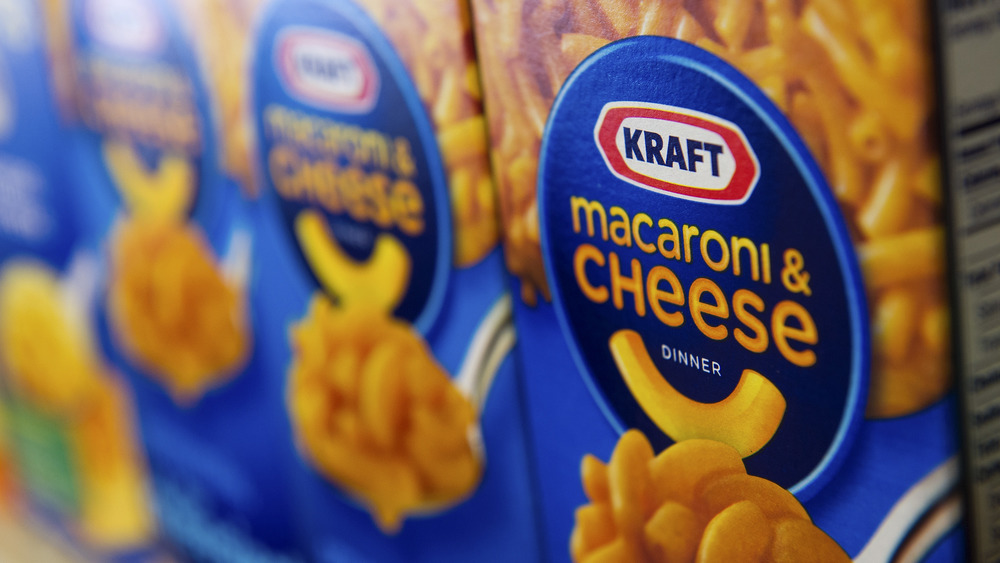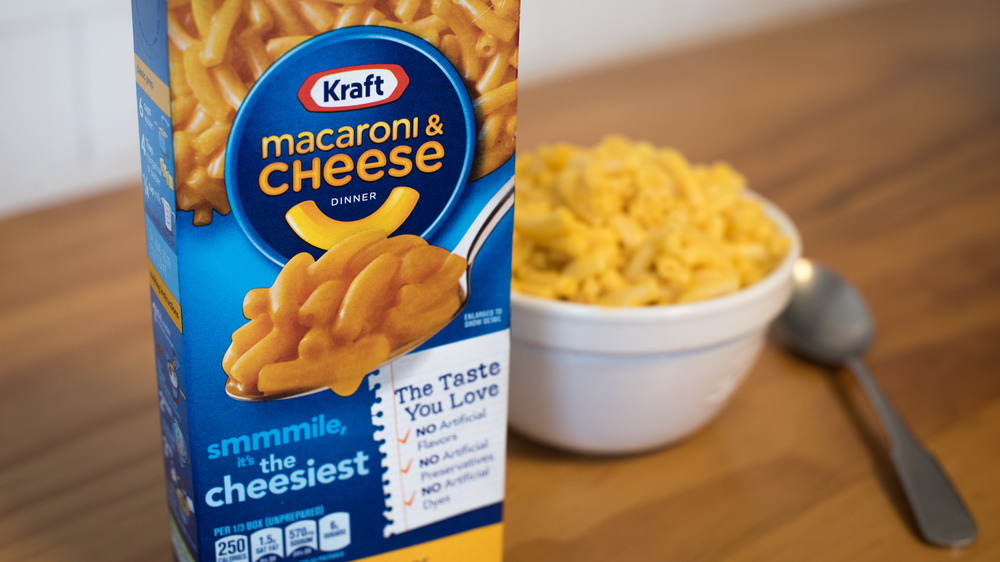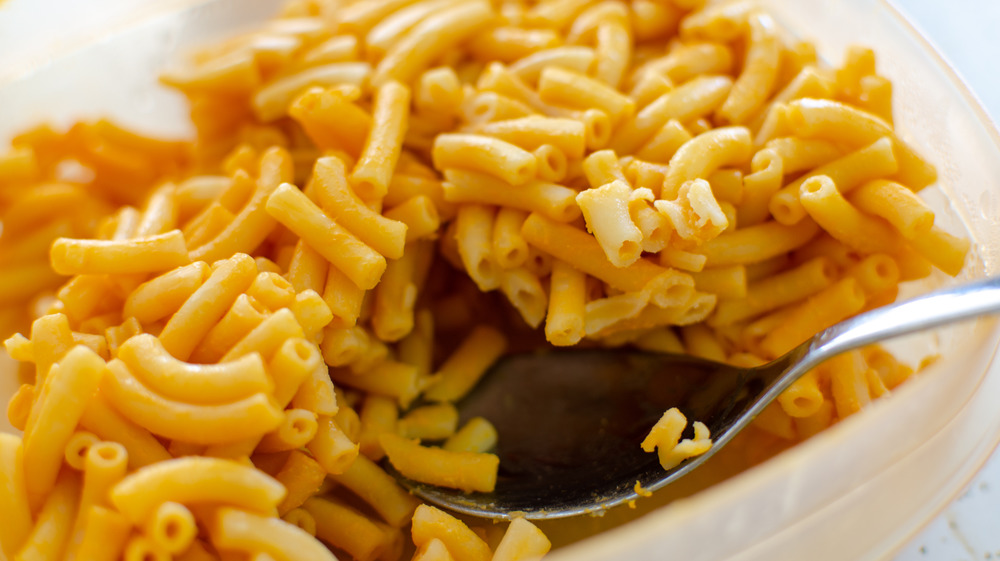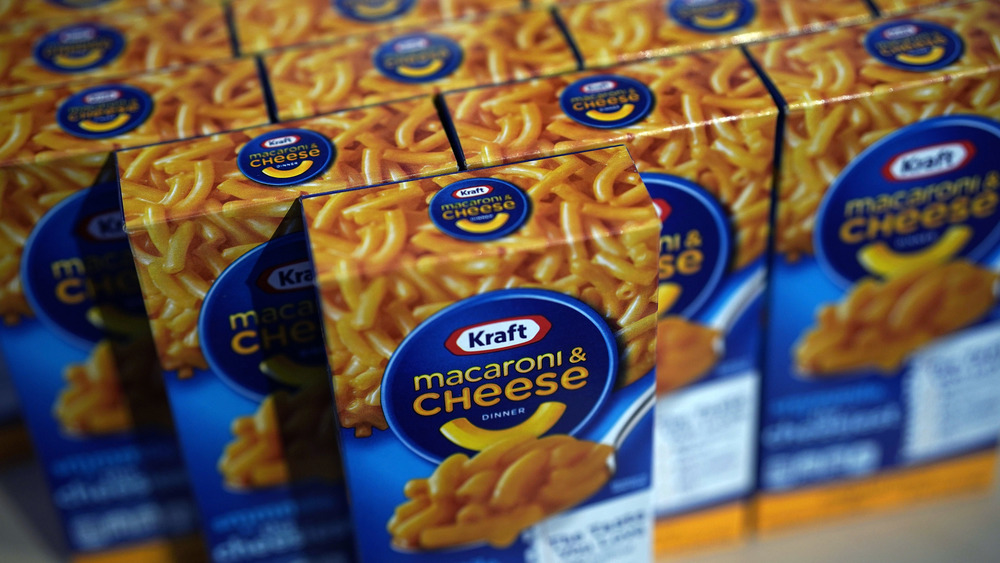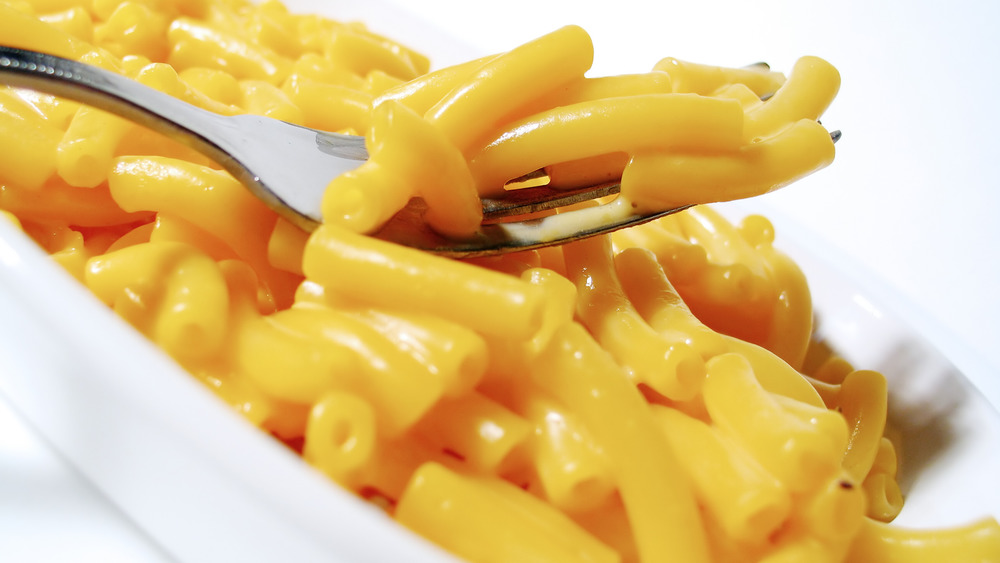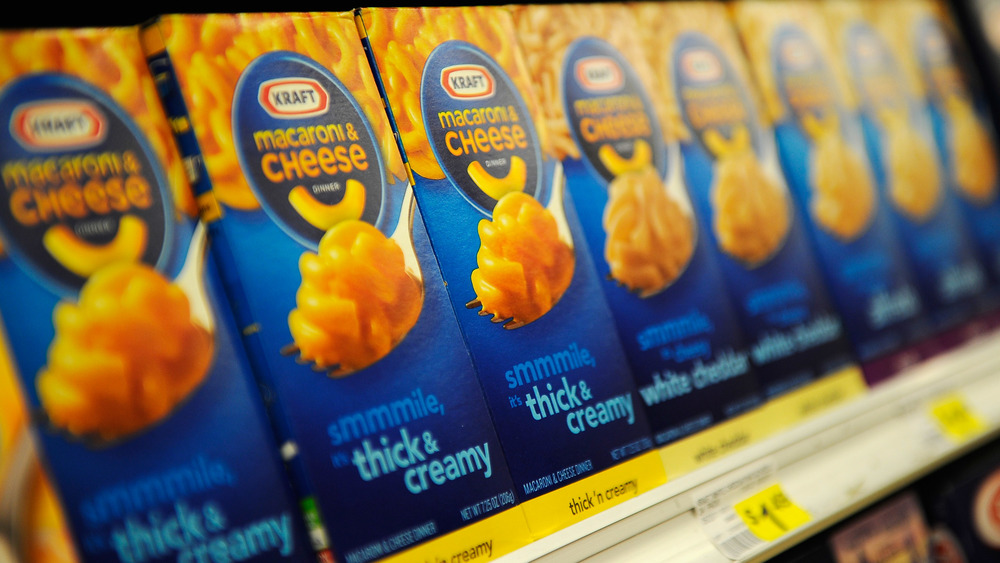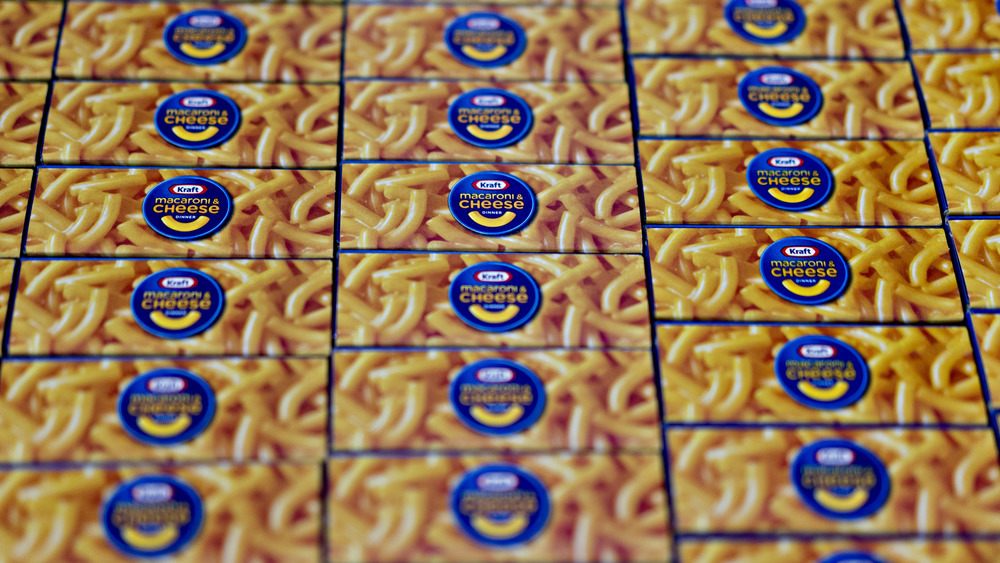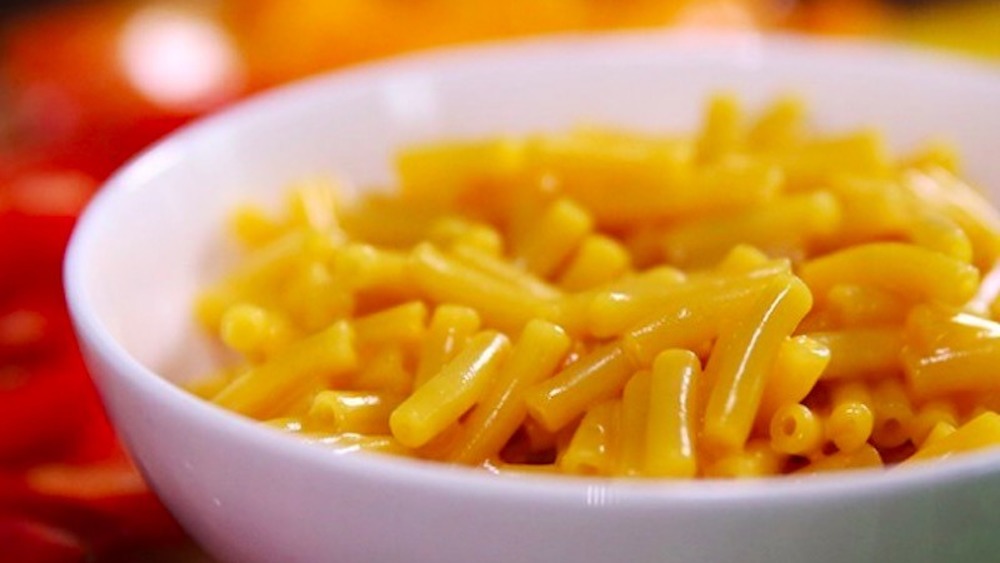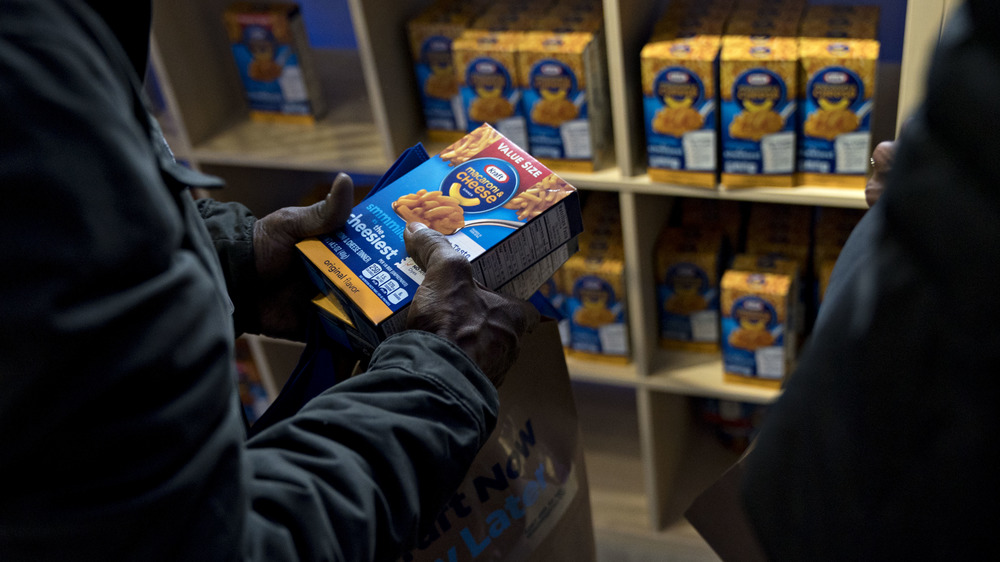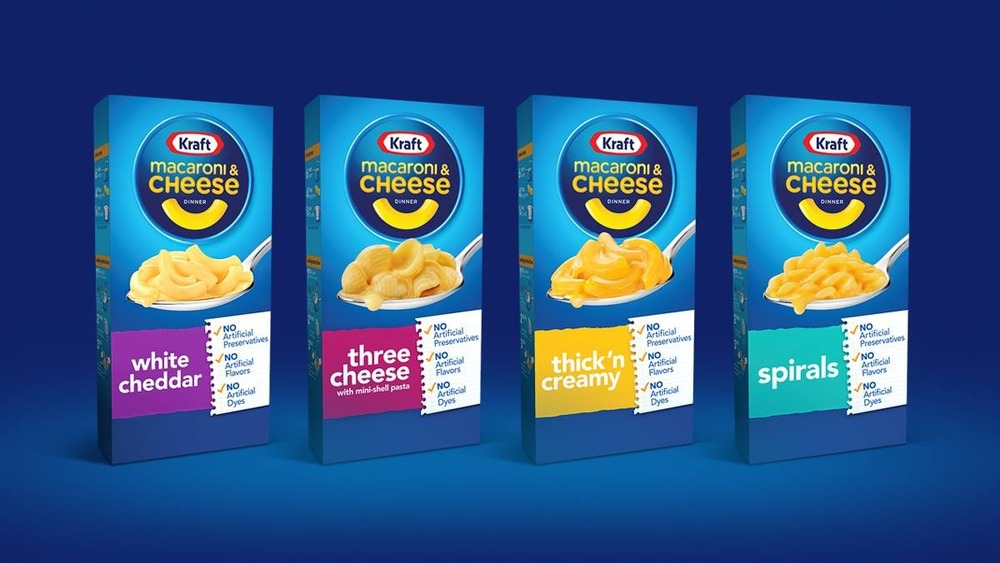This Is How Kraft Mac & Cheese Is Really Made
We may receive a commission on purchases made from links.
Whether you love it or hate it, you know that iconic blue box when you see it on the grocery store shelf. Chances are, you've probably eaten it more times than you can count. That's right — we're talking about the one and only Kraft Macaroni & Cheese. The boxed noodles and powder were debuted to Americans in 1937 (via Smithsonian Magazine), and have basically become a national treasure ever since, with somewhere around a million boxes being sold on the daily (per Insider). Because what's not love?
Kraft Mac & Cheese is delicious and ready to eat in under 10 minutes. It's the weeknight champion for working parents, the nostalgic (and cheap) comfort food of college students' dreams, and the ultimate after-school snack for kids of any age. Basically, this mac and cheese is for everyone, and we can't get enough of it.
So that leaves us with one question: How does this magical macaroni and cheese come to be? We've done the digging to get some answers. Keep reading to find out how Kraft Mac & Cheese is really made.
Kraft Macaroni & Cheese uses patented powdered cheese
When Kraft Mac & Cheese made its debut around World War II, it was an instant hit. But before this revolutionary boxed meal came an even bigger innovation from J.L. Kraft, the man behind the Kraft foods empire. In 1916, Kraft was awarded the first patent ever for creating processed cheese — which is basically a method for making a cheese product that is shelf stable and won't spoil quickly. We won't get into the chemistry of it all, but it is safe to say that processed cheese fundamentally changed the ways we eat.
After Kraft's processed cheese became a hit (thanks in part to the company's first major customer, the U.S. Army, which was looking to feed soldiers during World War I), the company wanted to expand to feed the masses (via Smithsonian Magazine). Processed cheese led to the invention of powdered cheese, and eventually the boxed mac and cheese dinner was born. This was right around the Great Depression and World War II, so the cheap, easy, and yet elevated meal became a staple in many American households (via Chicago Tribune).
Kraft Macaroni & Cheese starts with real cheese
As counterintuitive as it may seem, the bright orange, processed cheese powder that brings Kraft Macaroni & Cheese to life actually begins more like the cheese sauce it will become. And it all starts with real cheese. Kraft says for its powdered cheese, "We start by making our own cheese. We then blend that cheese with other ingredients to make a cheese sauce that has the one-of-a-kind taste you love." This cheese sauce gets a small amount of sodium phosphate added to it, which is the magic ingredient that helps bind the oil and water in cheese, so that it stays smooth and creamy when it melts (via Modernist Cuisine). At this point, the cheese is resembling something more like the Velveeta shells and cheese sauce we know and love. So how does it go from this to powder? Keep reading to find out.
Kraft uses food dehydrators to make its cheese
The final step in going from cheese to cheese powder involves a process that actually far outdates Kraft Macaroni & Cheese itself — food dehydration. The natural version of the process (curing, etc.) has been used by Indigenous Americans and some Eastern cultures for generations. Food dehydration dates back to the late 18th century (per Britannica). The main function of dehydrating food, either naturally, using heat, or more modern chemical processes, is to make it essentially non-perishable (via The New Yorker).
Today, it's so common that you can buy food dehydrators on Amazon for less than $45. And that's basically what Kraft uses, only smaller. Kraft says, "Similar to a food dehydrator you might have at home to dry out fruit like apples, we use a food dehydrator — just a much larger version. This removes the moisture from the cheese sauce and turns our Cheese Sauce into dry powder."
There are no artificial dyes in Kraft Macaroni & Cheese
Kraft Macaroni & Cheese can be identified in part by the distinct yellowish-orange color of its processed product. For a long time, that signature color came from the addition of synthetic food dyes. But that is not that case anymore. In 2015, thanks to growing consumer demand for more natural foods, Kraft announced that it was changing up the way it makes its famous macaroni and cheese. Going forward, the company eliminated the use of all artificial colors, flavors, and preservatives in its whole line of products, including the boxed mac and cheese.
When the changes were announced, some were concerned that the iconic Kraft Macaroni & Cheese flavor we know and love would be altered with the new recipe. Kraft nipped that in the bud with what it called "the world's largest blind taste test" and claimed that "fifty million boxes later ... people didn't notice a difference" (per Eater).
Kraft Macaroni & Cheese is made with a blend of spices
When Kraft removed the synthetic dyes from its boxed mac and cheese, it had to add something in its place to make sure the product still looked and tasted the same for consumers. Today, Kraft Macaroni & Cheese is made with a blend of spices that help achieve that goal. They include bright red paprika, which is infused into the noodles as well as used in the cheese sauce. Rich, yellow turmeric, which contains a host of health benefits in addition to the perfect mac and cheese hue, is also included. Finally, some annatto is added. For those who aren't familiar, annatto is extracted from the seeds of achiote trees, and it's basically food dye straight from nature (via Healthline).
According to Eater, Kraft massaged their new mac and cheese formula for over three years before they got it just right. And while there were a small number of mac and cheese lovers who petitioned Kraft to go back to their original recipe, most people embraced the changes.
Kraft Macaroni & Cheese is made with phthalates, but it's not clear what that means
While you won't find preservatives and artificial flavors in Kraft Mac & Cheese, you will find another controversial ingredient. Kraft's powdered cheese has been found to contain high levels of chemicals known as phthalates (via kleanupkraft.org). On its website, Kraft notes that it does not add any phthalates to its product, but the chemicals can apparently wind up in some manufactured products (which also include plastics, soaps, rubbers, ink, and more) during the production process (per CNN).
The issue with phthalates is that it's not clear how safe or harmful they actually are. Some medical experts believe these chemicals may disrupt humans' hormonal systems. CNN reports that phthalates have been banned in children's products since 2008 by the U.S. Consumer Product Safety Commission. On the other hand, the Centers for Disease Control and Prevention (CDC) says, "Human health effects from exposure to low levels of phthalates are unknown." On top of that, Kraft claims, "The trace levels [of phthalates] found in the one limited test of mac & cheese are well below any level of concern."
Kraft Macaroni & Cheese packs a protein punch
While no one is trying to claim that Kraft Macaroni & Cheese is a good substitute for a salad, the blue box is actually full of more nutrients than you might think. One box of Kraft Mac & Cheese contains about three servings, and each serving contains a whopping nine grams of protein. On top of that, Kraft Mac & Cheese is a great source of calcium and iron, with 10 percent of your recommended daily value of each in a serving. And having a little mac and cheese with kids won't be a diet breaker, either. There are just 3 grams of fat per serving, and no trans fat. Heck, have the whole box without feeling guilty. (Come on, we've all done it.) The only kicker is the sodium. With 570mg in each serving, you're looking at almost a quarter of your daily recommended intake right there.
Kraft Macaroni & Cheese may contain allergens, but there are alternatives
We know that Kraft Macaroni & Cheese does in fact contain real cheese. But it's a processed powdered cheese, so it's worth clarifying what that means for allergies and dietary restrictions. First of all, this may be surprising, but Kraft Mac & Cheese is not technically considered vegetarian (via vegblogger.com). That's because, per a FAQ on Kraft's corporate website, during the process of converting milk into cheese, enzymes from animal sources (including goat, sheep, and calves) are used. Kraft does note that it is "looking into new ways of processing our various lines of cheese products that would eliminate the need for enzymes that are derived from animal sources." So those who choose not to consume animal products should be aware of this when deciding whether they want to eat this mac and cheese.
Additionally, anyone with intolerance to gluten lactose may need to evaluate if they can eat Kraft Mac & Cheese. On the box's ingredients list, it clearly states that the product contains wheat and milk. There is some good news for some — Kraft does offer a gluten-free version of its boxed mac and cheese.
Kraft makes several cheese blends for mac and cheese flavors
What started out as a single box of macaroni and cheese has grown into an empire. Kraft has expanded way beyond its original recipe, and now offers dozens of Kraft Mac & Cheese products, in a variety of flavors, from three cheese to white cheddar. Kraft relies on a variety of its patented cheeses powders to create these flavors.
And Kraft keeps coming up with more. The company is always trying out new, limited-edition flavors. One of their most recent concoctions is Candy Kraft Mac & Cheese. According to Kraft, it's "made with the same cheesy Kraft Mac & Cheese Americans know and love, but includes a candy flavor packet to turn the mac & cheese pink and add hints of sweet candy flavor" (via Food & Wine). If you're not sure how you feel about it, you're not alone. Let's just say some work out better than others.
